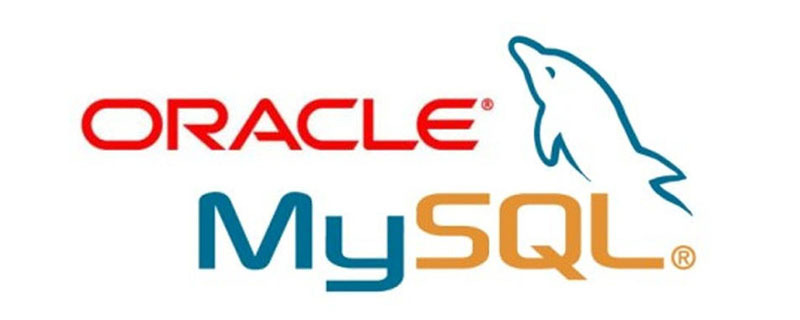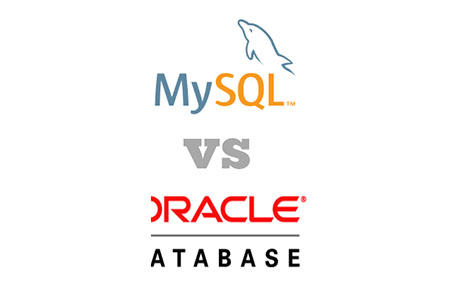What are the differences between mysql and oracle?
The differences between mysql and oracle are: 1. Oracle database is an object-relational database management system, which requires a fee; MySQL is an open source relational database management system, which is free; 2. The difference in database security; 3. Differences in object names; 4. Differences in temporary table processing methods, etc.

The operating environment of this article: Windows7 system, Dell G3 computer, Oracle version 9.0.1.1.2&&mysql8.
MySQL and Oracle are both popular relational database management systems (RDBMS) that are widely used around the world; most databases work in a similar way, but there are always some differences here and there between MySQL and Oracle . This article will compare Oracle and MySQL and introduce the differences between Oracle and MySQL. I hope it will be helpful to you.
What is the difference between MySQL and Oracle? The characteristics of the two databases are different, so compared with Oracle, MySQL is used differently; compared with MySQL, Oracle is used differently. Their characteristics are also different. Let's take a closer look at the differences between MySQL and Oracle.
1. The essential difference
Oracle database is an object-relational database management system (ORDBMS). It is often called Oracle RDBMS or simply Oracle and is a database.
MySQL is an open source relational database management system (RDBMS). It is the most used RDBMS in the world and runs as a server providing multi-user access to multiple databases. It is an open source, free database.
2. Database security
MySQL uses three parameters to authenticate users, namely username, password and location; Oracle uses many security features, such as username , passwords, profiles, local authentication, external authentication, advanced security enhancements, and more.

3. Differences in SQL syntax
Oracle’s SQL syntax is very different from MySQL. Oracle provides greater flexibility with a programming language called PL/SQL. Oracle's SQL*Plus tools provide more commands than MySQL for generating report output and variable definitions.
4. Storage differences:
Compared with Oracle, MySQL does not have table spaces, role management, snapshots, synonyms and packages, and automatic storage management.
5. Differences in object names:
Although some schema object names are not case-sensitive in Oracle and MySQL, such as columns, stored procedures, indexes, etc. . But in some cases, case sensitivity is different between the two databases.
Oracle is case-insensitive for all object names; while some MySQL object names (such as databases and tables) are case-sensitive (depending on the underlying operating system).
6. Running program and external program support:
Oracle database supports several programming languages that are written, compiled and executed from within the database. Furthermore, to transfer data, Oracle Database uses XML.
MySQL does not support the execution of other languages within the system, nor does it support XML.
7. Comparison of character data types between MySQL and Oracle:
There are some differences in the character types supported in the two databases. For character types, MySQL has CHAR and VARCHAR, with a maximum allowed length of 65,535 bytes (CHAR can be up to 255 bytes, VARCHAR is 65.535 bytes).
However, Oracle supports four character types, namely CHAR, NCHAR, VARCHAR2 and NVARCHAR2; all four character types need to be at least 1 byte long; CHAR and NCHAR can be up to 2000 bytes, NVARCHAR2 And the maximum limit of VARCHAR2 is 4000 bytes. Might be extended in the latest version.
8. Comparison of additional features between MySQL and Oracle:
MySQL database does not support any features on its server, such as Audit Vault. Oracle, on the other hand, supports several extensions and programs on its database servers, such as Active Data Guard, Audit Vault, Partitioning, and Data Mining, etc.
9. The difference between temporary tables:
Oracle and MySQL handle temporary tables in different ways.
In MySQL, temporary tables are database objects visible only to the current user session, and these tables are automatically deleted once the session ends.
The definition of temporary tables in Oracle is slightly different from MySQL in that temporary tables exist once they are created until they are explicitly dropped and are visible to all sessions with appropriate permissions. However, data in a temporary table is visible only to the user session that inserted the data into the table, and the data may persist across transactions or user sessions.
10. Backup types in MySQL and Oracle:
Oracle provides different types of backup tools, such as cold backup, hot backup, export, import, Data Pump. Oracle provides the most popular backup utility called Recovery Manager (RMAN). Using RMAN, we can automate our backup schedule and restore database using very few commands or storage scripts.
MySQL has mysqldump and mysqlhotcopy backup tools. There is no utility like RMAN in MySQL.
11. Database management of Oracle and MySQL:
In the database management part, Oracle DBA is more profitable than MySQL DBA. Oracle DBA has a lot of scope available compared to MySQL.
12. Database certification:
MySQL certification is easier than Oracle certification.
Unlike Oracle (when set up to use database authentication) and most other databases that only use username and password to authenticate users, MySQL uses additional parameters when authenticating users to location. This location parameter is usually a hostname, IP address, or wildcard.
Using this additional parameter, MySQL can further restrict user access to the database to specific hosts or hosts in the domain. Additionally, this allows different passwords and permission sets to be enforced for users based on the host from which they are connecting. Therefore, user scott logged in from abc.com may or may not be the same as user scott logged in from xyz.com.
Summary: The above is the entire content of this article, I hope it will be helpful to everyone's study.
The above is the detailed content of What are the differences between mysql and oracle?. For more information, please follow other related articles on the PHP Chinese website!

Hot AI Tools

Undresser.AI Undress
AI-powered app for creating realistic nude photos

AI Clothes Remover
Online AI tool for removing clothes from photos.

Undress AI Tool
Undress images for free

Clothoff.io
AI clothes remover

Video Face Swap
Swap faces in any video effortlessly with our completely free AI face swap tool!

Hot Article

Hot Tools

Notepad++7.3.1
Easy-to-use and free code editor

SublimeText3 Chinese version
Chinese version, very easy to use

Zend Studio 13.0.1
Powerful PHP integrated development environment

Dreamweaver CS6
Visual web development tools

SublimeText3 Mac version
God-level code editing software (SublimeText3)

Hot Topics
 1386
1386
 52
52
 MySQL: An Introduction to the World's Most Popular Database
Apr 12, 2025 am 12:18 AM
MySQL: An Introduction to the World's Most Popular Database
Apr 12, 2025 am 12:18 AM
MySQL is an open source relational database management system, mainly used to store and retrieve data quickly and reliably. Its working principle includes client requests, query resolution, execution of queries and return results. Examples of usage include creating tables, inserting and querying data, and advanced features such as JOIN operations. Common errors involve SQL syntax, data types, and permissions, and optimization suggestions include the use of indexes, optimized queries, and partitioning of tables.
 Why Use MySQL? Benefits and Advantages
Apr 12, 2025 am 12:17 AM
Why Use MySQL? Benefits and Advantages
Apr 12, 2025 am 12:17 AM
MySQL is chosen for its performance, reliability, ease of use, and community support. 1.MySQL provides efficient data storage and retrieval functions, supporting multiple data types and advanced query operations. 2. Adopt client-server architecture and multiple storage engines to support transaction and query optimization. 3. Easy to use, supports a variety of operating systems and programming languages. 4. Have strong community support and provide rich resources and solutions.
 MySQL's Place: Databases and Programming
Apr 13, 2025 am 12:18 AM
MySQL's Place: Databases and Programming
Apr 13, 2025 am 12:18 AM
MySQL's position in databases and programming is very important. It is an open source relational database management system that is widely used in various application scenarios. 1) MySQL provides efficient data storage, organization and retrieval functions, supporting Web, mobile and enterprise-level systems. 2) It uses a client-server architecture, supports multiple storage engines and index optimization. 3) Basic usages include creating tables and inserting data, and advanced usages involve multi-table JOINs and complex queries. 4) Frequently asked questions such as SQL syntax errors and performance issues can be debugged through the EXPLAIN command and slow query log. 5) Performance optimization methods include rational use of indexes, optimized query and use of caches. Best practices include using transactions and PreparedStatemen
 How to create cursors in oracle loop
Apr 12, 2025 am 06:18 AM
How to create cursors in oracle loop
Apr 12, 2025 am 06:18 AM
In Oracle, the FOR LOOP loop can create cursors dynamically. The steps are: 1. Define the cursor type; 2. Create the loop; 3. Create the cursor dynamically; 4. Execute the cursor; 5. Close the cursor. Example: A cursor can be created cycle-by-circuit to display the names and salaries of the top 10 employees.
 How to create oracle dynamic sql
Apr 12, 2025 am 06:06 AM
How to create oracle dynamic sql
Apr 12, 2025 am 06:06 AM
SQL statements can be created and executed based on runtime input by using Oracle's dynamic SQL. The steps include: preparing an empty string variable to store dynamically generated SQL statements. Use the EXECUTE IMMEDIATE or PREPARE statement to compile and execute dynamic SQL statements. Use bind variable to pass user input or other dynamic values to dynamic SQL. Use EXECUTE IMMEDIATE or EXECUTE to execute dynamic SQL statements.
 How to connect to the database of apache
Apr 13, 2025 pm 01:03 PM
How to connect to the database of apache
Apr 13, 2025 pm 01:03 PM
Apache connects to a database requires the following steps: Install the database driver. Configure the web.xml file to create a connection pool. Create a JDBC data source and specify the connection settings. Use the JDBC API to access the database from Java code, including getting connections, creating statements, binding parameters, executing queries or updates, and processing results.
 How to use triggers for oracle
Apr 11, 2025 pm 11:57 PM
How to use triggers for oracle
Apr 11, 2025 pm 11:57 PM
Triggers in Oracle are stored procedures used to automatically perform operations after a specific event (insert, update, or delete). They are used in a variety of scenarios, including data verification, auditing, and data maintenance. When creating a trigger, you need to specify the trigger name, association table, trigger event, and trigger time. There are two types of triggers: the BEFORE trigger is fired before the operation, and the AFTER trigger is fired after the operation. For example, the BEFORE INSERT trigger ensures that the age column of the inserted row is not negative.
 How to stop oracle database
Apr 12, 2025 am 06:12 AM
How to stop oracle database
Apr 12, 2025 am 06:12 AM
To stop an Oracle database, perform the following steps: 1. Connect to the database; 2. Shutdown immediately; 3. Shutdown abort completely.




